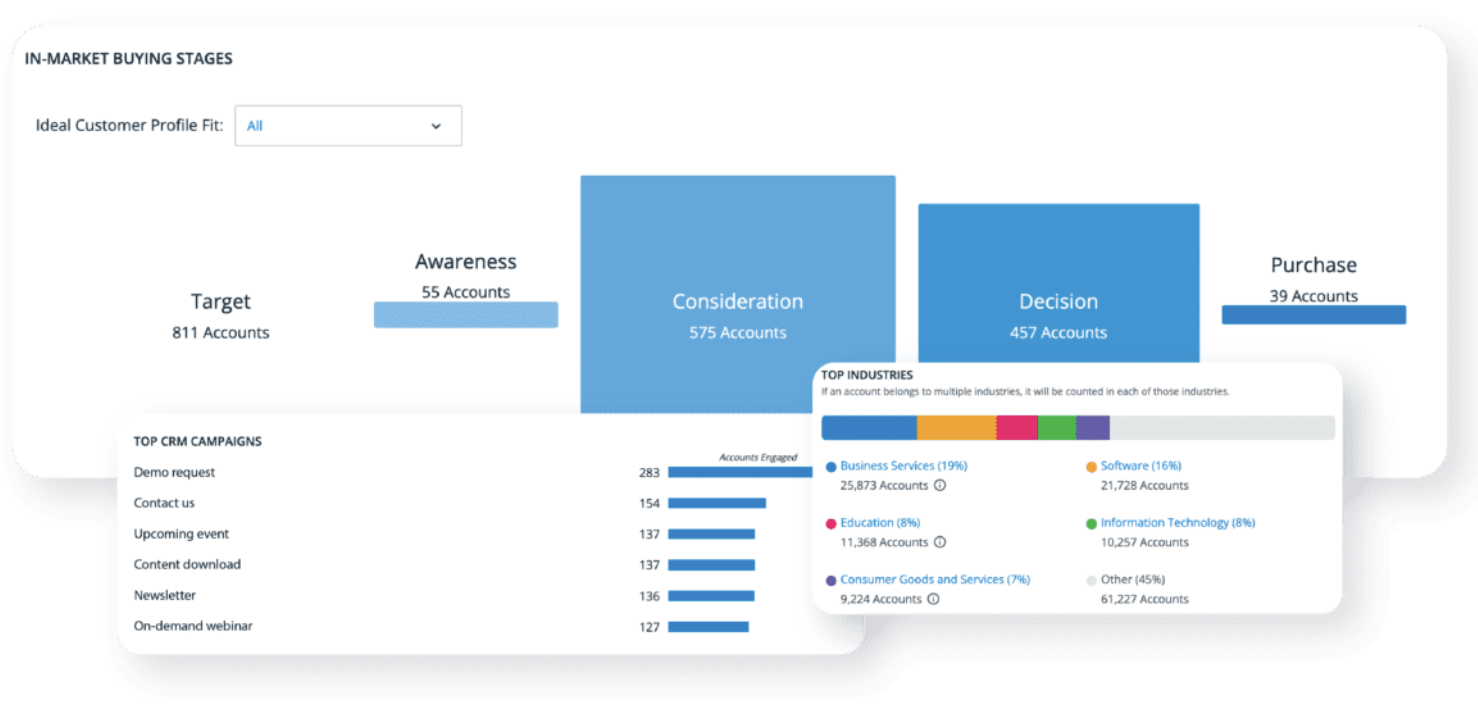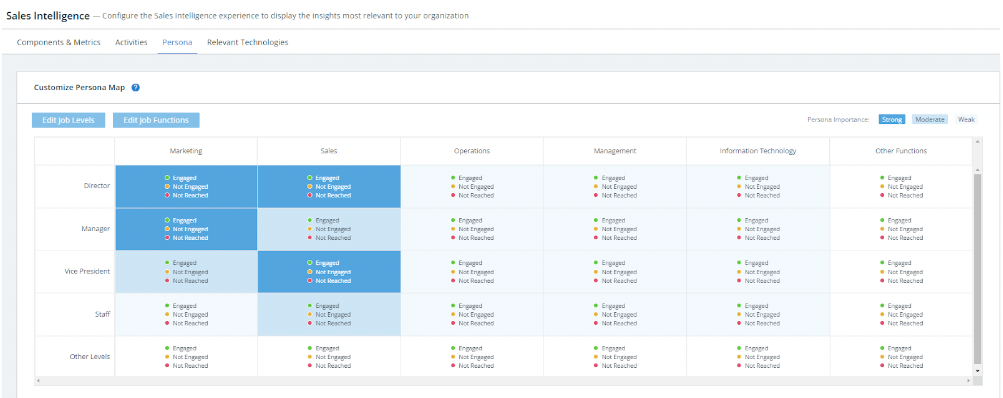AI is now an essential part of the sales toolkit, but there’s a sales superpower it can never truly replicate: Empathy.
Empathy is understanding that your customer’s ultimate goal isn’t really the business benefit you’re selling — it’s solving the problems keeping them up at night.
While AI can’t put itself in your buyer’s shoes, it can help you build meaningful connections more quickly. When incorporated into a B2B sales platform, AI can help identify and make sense of data to answer questions like:
- When accounts are ready to buy
- Whether they’re a good fit for your business
- Who to contact
- What they’re interested in
By using AI to spot buying signals and better understand your buyers, it becomes easier to start conversations, add value, and build trust. Suddenly you can skip the awkward preliminaries and get to the important stuff: helping your customers solve their problems.
Engage Prospects That Want to Hear From You
Read the room. If a prospect …
- Isn’t researching anything related to your solution
- Isn’t visiting your website
- Isn’t engaging with content
- And isn’t opening your emails
… it’s unlikely they’re ready to hear from you.
As G2 CRO Mike Weir explains, being realistic benefits both parties:
“It’s for the benefit of the client, because we don’t want to waste their time either by reaching out until they’re ready to have a conversation,” Weir says. “And it’s beneficial for our time, too. We want to optimize that time.”
But there’s a problem. Traditionally, sales people can’t gauge prospects’ interest because their buyers are in stealth mode, conducting research anonymously.
Operating based on glimpses of a buyer’s interest — or no visibility at all — leads sales folks to lean into cold calls and spammy outreach based on best guesses. And that’s a sure-fire way to alienate buyers rather than build relationships.
Prioritize and Personalize
AI helps you uncover in-market accounts — i.e. the ones actually looking for solutions like yours. Better still, some B2B AI platforms can peel back another layer, taking you down to a persona level to reveal:
- Which contacts in an account are most engaged
- What content they’re consuming
- The keywords they’re researching
As 6sense sales leader Dasha Vasilyeva explains in the video below, this knowledge means you can prioritize your best-fit accounts, then personalize engagement for individual personas appropriately.
Not only are you reaching out to receptive contacts, you’re adding value by addressing relevant topics straight away — laying the foundations for buyers to see you as a trusted advisor.
Provide Relevant Advice at The Right Time
Understanding the topics your buyers care about is an empathy hack. It’s a shortcut to speaking their language. This hack becomes even more potent when you also know where an account is in its buying journey.
Identifying a buyer’s problems and showing how you can solve them makes you helpful — providing this knowledge exactly when they need it makes you indispensable.
In fact, teams that engage accounts at the right time in their journey experience a 120% improvement in revenue generation. Timing + relevance = increased revenue.
An AI trained on B2B sales data can make it easier for you to engage buyers with the right message, at the right time, by analyzing an account’s signals to predict its buying stage.

Is your buyer at the beginning of their journey weighing up different solutions, or are they ready to buy?
Knowing a prospect’s buying stage immediately brings an added level of empathy to your outreach. You can share appropriate content for the buying stage and tailor your engagement accordingly.
Bring Together The Buying Group
B2B buyers hunt in packs. Gartner research shows the average size of a buying team sits between 14 and 23 people. That means closing deals today means winning over a large group of people. The more individuals you can meaningfully connect with in the buying group, the better your chances are of converting them into customers.
While your internal champions can help influence the rest of the buying team, don’t leave your success up to them. It’s your job to identify other personas within the buying group and bring them along on the journey.
Thankfully, buying groups no longer need to be cloaked in secrecy. AI can help identify buying team members and find gaps in engagement, empowering you to start creating meaningful connections with each member of the buying team.

Once you uncover the personas that need more attention, it’s time to use the same tailored approach that opened doors to the account in the first place.
This might sound like a lot of work for each persona, but you can share the load and automate much of the execution. Bring together your revenue team to engage buyers on different channels depending on their stage in the buying journey.
For example:
- Marketing can deliver targeted ads to warm up other members of the buying groups
- BDRs can help you multi-thread decision makers
- You can pull contacts into tailored Salesloft cadences, or invite them to relevant events
As your account progresses, AI can then be used to spot additional engagement that indicates when an account or specific buying personas may be ready for direct outreach.
Use AI Intentionally
AI is a super smart tool, but it’s a tool nonetheless.
By using AI to intentionally empathize with your buyers, you can build stronger connections faster.
Whether it’s researching accounts, understanding the buying journey, or identifying key decision makers, AI can help you become a better customer advocate and, ultimately, close more business.
Looking for more smart ways to connect with your buyers? Get 12 psychological principles to hook your audiences’ attention and persuade them to take action here.



